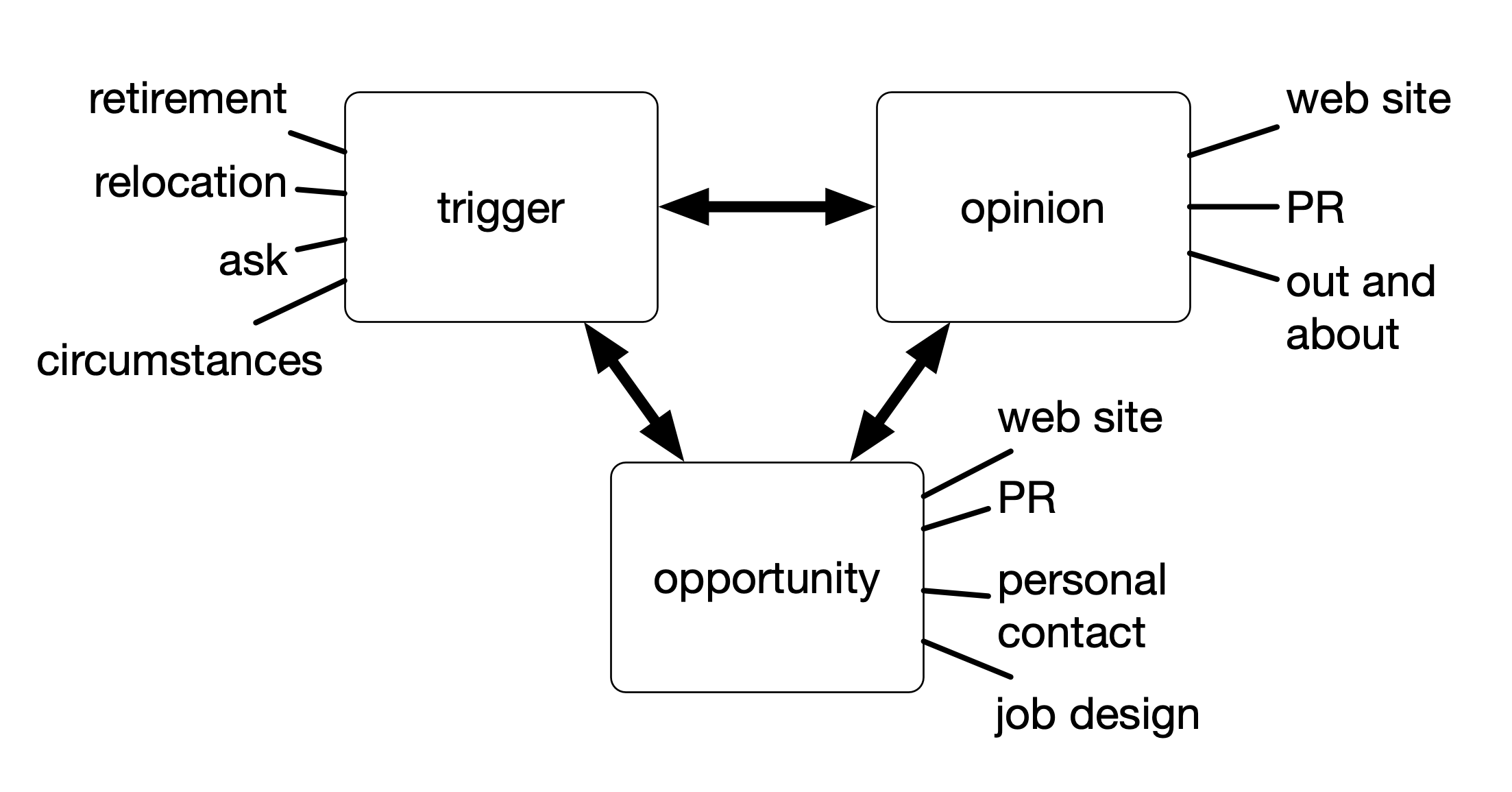One of a series of papers on managing volunteers
Getting volunteers to... volunteer
Written by John Berry on 23rd September 2020. Revised 18th July 2024.
4 min read
 Getting enough volunteers with the right skill-set is huge problem for organisations reliant on volunteers. Managers of volunteers must continually engage in recruitment. But how does the manager of volunteers succeed in getting ‘the right people in the right jobs, always’.
Getting enough volunteers with the right skill-set is huge problem for organisations reliant on volunteers. Managers of volunteers must continually engage in recruitment. But how does the manager of volunteers succeed in getting ‘the right people in the right jobs, always’.
There’s a simple three-step model that is useful in understanding the problem, and its solution.
Opinion
Like chicken and egg, it’s difficult to know where to start. From the organisation’s perspective it’s with opinion, or attitude. Would-be volunteers must have a good opinion of the organisation, a good positive attitude towards it. Building an opinion in potential volunteers is a long-term ongoing activity. But for the would-be volunteer, everything starts with the trigger.
Everyone follows a life stages trajectory from youth to retirement. Along the way, individuals evolve. In their early teens they are too busy doing to be concerned with causes.
In early adulthood, they build opinion about causes and it’s then that many decide to volunteer. They learn about global warming, for example, are aghast and moved to act – and they volunteer as activists.
Lifestages
In their 30s and 40s, they become settled in careers and have children. At this stage, they see atrocities, like homelessness and migration, and are moved to volunteer. Or as parents, they hear that the local youth club is going to fold, and volunteer as parent leaders – at least for as long as their kids are members.
And in middle-age and into retirement, they relocate or reduce work commitment or stop working altogether, and hence have time on their hands.
In every case, something triggers action. In every case, something moves the person to do something and volunteer. The trigger will be different at each life stage. But for the organisation, knowing that people might be out there experiencing a ‘trigger’ event, is no good unless the managers in those organisations are ready with active marketing.
Being ‘ready’ starts many years before.
Triggering action
Before the trigger means anything, the potential volunteer must have a positive opinion about the organisation’s cause. This means engaging with all the usual marketing tools like web site, PR and face to face events. Those events must be designed to ensure that when the potential volunteer experiences the organisation, they come away with the sub-conscious idea that that would be a cause to which they might give time.
Targeting the right demographic is essential here if marketing effort is to be successful. This involves knowing the profile of the typical volunteer for that cause.
But trigger and opinion are no good unless the potential volunteer can perceive how they might contribute, and how they might benefit. Remember that with opinion, they are minded. With trigger, they might act in the organisation’s favour. But there’s nothing certain that the organisation would be the beneficiary when the time comes. The would-be volunteer must perceive a role for themselves.
Opinion marketing is about laying out how worthy the cause is. Opportunity marketing is different. Opportunity marketing shows anyone who might enquire, what they might do, and what a difference they might make. Remember the reasons why people volunteer in the first place: to satisfy their affiliation, growth and significance needs. Opportunity marketing shows would-be volunteers how, subliminally, those needs would be met.
This could be you
Again, the traditional marketing tools are used, but this time, the aim is to say, “This could be you”. The organisation web site might run a series of testimonials. The Tomorrow’s Engineers website is a brilliant example of this. The jobs are not voluntary, but their Real Jobs page sets out a host of possibilities at https://www.tomorrowsengineers.org.uk/real-jobs/ (at July 2024, this diverts to Neon but the jobs are the same). Click on some of the jobs to see the diversity and detail.
And ultimately, of course, it must be clear that for good volunteer candidates, the organisation has the ability to design a role around the person. All charities and other organisations offering volunteering must engage with job design. Someone who has the right opinion and is ‘triggered’ must not be turned away just because there’s no suitable role right now.
So, there we have it. Recruiting volunteers is a long-term activity. Positive opinion must be created in potential volunteers. As they come closer to trigger points in their career journey, they must be given tangible information showing how they could contribute in real roles.
Then, on experiencing their trigger, they must know where to go to start discussions about their next volunteer engagement. When the trigger comes, the volunteer must turn away from hobbies and interests that would otherwise consume their time toward volunteering. They must turn specifically towards the organisation and its volunteer roles. Ideally, they should be known by the organisation, and can then be asked in person.